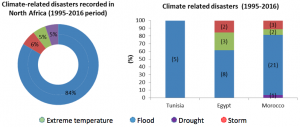For the first time the world is facing such pathetic migrant & refugee crises for ever after World War II. Migrant crises are not new in history but new addition is the causes of migrant crises are rooting from divergent areas. Environmental degradation or climate change is also another root cause of migration and refugee crises. According to the Internal Displacement Monitoring Center, since 2008,an average 26 million people per year were internally displaced due to natural disasters, at the global level. Over one billion people were hit by drought between 1994 and 2013, despite the fact that droughts account for only 5% of extreme events over the period. The Stern review warns that 200 million coastal inhabitants will be displaced by 2050 due to rising sea levels and attendant inundation from storm surge.
There are deep links between migrant and refugee crises and climate change. Extreme climate phenomena declines food safety then people has to migrate in search of food. Even some extreme environmental events wash out their habitats then they become forced to displace within country or abroad.
But the fact is when we recognize other roots of migrant and refugee crises we overlook climate change impact on this.
The relation between Climate Change and Migration:
Climate change, migration and environment are inter-related. Historically, human beings migrated from country to county to escape from environmental degradation or in search of food. It was ancient time when people weren’t such modernized to face natural change. They have to migrate in course of seasonal change. It was natural. Such migration had both positive and negative impact. Migrating country to country, their inventory power developed and sustaining in such situation they learned to survive. Then evolution started.
But then time migration and today’s migration had so far difference. Present crises are mostly man-made. There are three kind of effect from climate change on human being which causes climate migrant
- Sea level rises which engulfs low level countries. People lose their habitants.
- Environmental degradation is reducing fertility of land.
- Though sometimes direct effects aren’t visual but people suffer. Like diseases.
So, by environmental degradation people faces various dimension of insecurity like habitual insecurity, food insecurity etc. For example cyclone Pam devastated small island Vunuatu and desertification in African Shell displaced thousands of people.
We know global warming consequences to the rise of sea level. Melting ice from Atlantic increasing sea level and thus a large number of islands will be plunged. The inhabitants of these areas have to find new area to survive. Besides, some other coastal areas are having salinity losing their productivity rapidly.
These incidents are causing internal and external displacement of migrants.
The status of Climate Migrant:
According to 1951 Convention Relating to the Status of Refugees a is someone who is “well-founded fear of being persecuted for reasons of race, nationality, membership of a particular social group or political opinion, is outside the country of his national and is unable or, owing to such fear, is unwilling to avail himself of the protection of that country; or who not having nationality and being outside the country of his former habitual residence as a result of such events, is unable or, owing to such fear, is unwilling to return to it”
And migrants are who “choose to move not because of a direct threat of persecution or death, but mainly to improve their lives by finding work, or in some cases for education, family reunion, or other reasons. Unlike refugees who cannot safely return home”- according to UNHCR
The biggest challenge is that Climate Migrant or climate-induced migrant has no legally defined though it is used all over the world. Lately COP-21 has initiated to define climate migrants or climate migration.
Submerging land and climate migrant:
When we discuss about climate migrants we must have to look haw climatic change disappearing world’s lands, forests, islands. The most affected are small island developing countries. According to United Nations Department of Economic and Social Affairs 52 territories are vulnerable on this regard. This can produce 50 million of climate migrant and refugees. Maldives, Bangladesh, Taiwan and such other countries are most victims. According to Environmental Protection Agency (EPA) global sea level has risen by 8 inches since 1970 and it will be about 16 inches within 2090. The island of Kiribati, Maldives, Seychelles, Torres Strait Island, Tegua, Solomon Island, Palau, Carteret Island, Tuvalu and Bangladesh will be submerged completely. In 2009, then-President Mohamed Nasheed staged a cabinet meeting underwater to raise awareness about the future of the country. It very important that this is not a prediction rather it is happening. According to a UN report in 2008 that there were 20 million people displaced due to climate change.
Desertification and Climate Migrant:
Another cause of climate migration is desertification which is an extreme consequence of climate change. As global temperature is leveling higher than higher, Ozone layer are declining, lands are becoming drier than ever. Ecological balance is disrupting. Like the Shael region in North West Africa, the region is consisted of 17 countries, is home to around 309 million people and the population is growing on an average of 3% per year have faced climate migrant crises. Since 1970 the world is having abnormal rainfall. Burkina Faso has had 50mm of less rainfall while Nigeria has seen to have 250mm of increased rainfall on average. It is for example. The 2007 IPCC report estimates that a global temperature rise of 2 to 3 degrees Celsius (3.6 to 5.4 degrees Fahrenheit) could contribute to lower crop yields in Africa, the Middle East, and Southern Asia by 30 to 40 percent. The same report also finds that yields from rain-fed agriculture could fall by up to 50 percent by 2020. Such kind of desertification is resulting food crises. Thus people are becoming climate migrant.
The Thematic Impute paper analysis:
In a research paper named Thematic Impute Paper by UN University said that migration in North Africa is the result of various kinds of fact of migrant crises. This Thematic Input Paper (TIP) provides an overview and a succinct discussion of migration, development and climate change in North Africa. The TIP describes current migration trends in Egypt, Morocco and Tunisia and discusses the links between migration, development and climate change that are relevant to the future socio-economic development of the region.

Solution to Climate Migrant crises:
After discussing the article it is clear that present devastating migrant crises is the result of climate change. So, to reduce the problem we have to check environmental pollution. We can take these initiatives-
- Reducing carbon emission
- Promoting climate friendly technologies
- Funding for climate effected countries
In COP-21 leaders from all over the world negotiate to reduce carbon emission but there are a few results. There were promising signs at Paris – the US Secretary of State John Kerry announced he would double U.S. financing for adaptation to more than $800 million per annum. However, only 16 percent of current public climate financing goes to adaptation and there is a major shortfall in financing for adaptation. In 2012 – 2013 public financing was between 23 to 26 billion USD yet developing countries will need at least $70 billion per annum by 2013. Developed countries are most responsible for climate change as well as migrant crises. So they have to come forward because if it continues once it will harm their existence also.
read more article on Migrant and Refugee
Sharif Mustajib
student, International Relations
University of Chittagong.

Share your thoughts
One Reply to “Relation between Climate Change and Migrant Crisis”